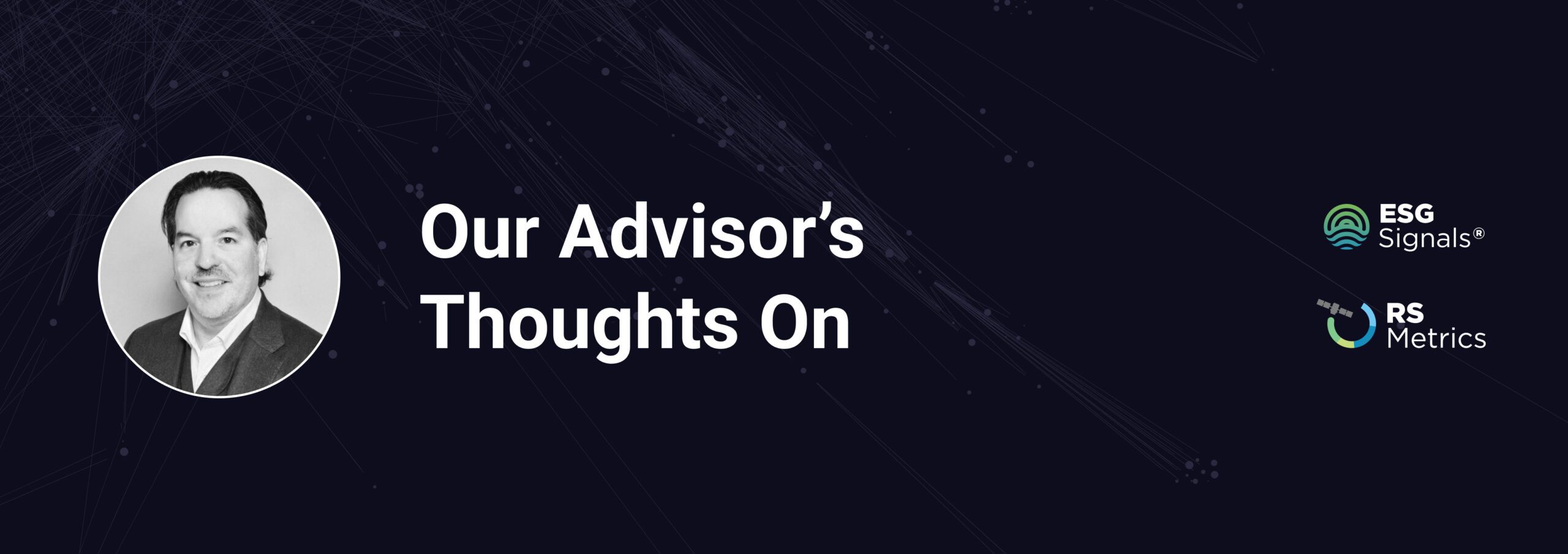This month “Our Advisor’s Thoughts On…”is looking a little different. We sat down for an interview with one of our newest Board of Advisors members and Head of Sales — James Gavilan. With more than 24 years of experience in the commodities world, Jimmy shared his thoughts on what the most prevalent industry topics in 2021 are and why every C-level executive should be looking at ESG right now.
Tell me a little bit about your background and what brought you to this point as an advisor for RS Metrics…
I have been in the commodities world for about 24 years. I’d like to say that my career has taken sort of two paths… The banking side of my career was the initial side. I spent 18 years working for a host of commodity derivative banks, where I got exposure to multiple assets and pure risk management from a derivative perspective. And also, from a point of view of providing risk management solutions to clients, which were typically producers, corporates, and central banks. With respect to RS Metrics, the interest and opportunity to work together began about a couple of years ago when I first met with the CEO, Maneesh Sagar. I was able to appreciate RS Metrics from a base metals point of view, given the MetalSignals™ platform and around the same time I was introduced to ESGSignals® platform. It also heightened my interest in working with the group and here I am today as an advisor, helping develop their portfolio of clients and the way that the company is reaching out to the industry.
It seems like you definitely have a lot of experience in the industry… What are some of the commonalities you notice when you look at the industry from a mining, financing, or FinTech side that make ESGSignals® a compelling product?
Well, certainly one of the definite commonalities that I found between mining, financing, FinTech are three major themes that have dominated my life and my clients’ that are addressed through this platform. Those themes would be liquidity, risk management, and peer differentiation. I think when you look at mining and financing or other PaaS solutions that are out there, they’re trying to address only one of these three key points. Any C-suite officer or a leader of an organization, regardless of industry, is going to always be focused on liquidity, maximizing that liquidity and risk management (whether it’s headline risk, environmental risk, shareholder activism, or even by-product hedging), and also peer differentiation (what makes a company unique). ESGSignals® addresses those three core issues in a very unique way that I don’t think is available in the market at this point.
And what do you think are some of the main risks clients face when tapping into the ESG sector?
This is a multi-billion dollar and growing industry sector. So, the risk, I feel, is not so much an overt risk for a mining client or a corporate — it’s an opportunity cost risk. You know, the FOMO, in common jargon nowadays, the fear of missing out. You don’t want to miss out on this avenue of liquidity. You don’t want to miss out on the work that the mining industry has done for decades through CSR and other initiatives. Now there is an opportunity to actually monetize that, quantify it, and make participating organizations open to these new avenues of liquidity.
Peer differentiation is also a risk that a client faces — you want to be in the right group. You don’t want to be lumped in as the traditional mining view is — as a dirty industry. This is a model that has been refined over years and the commodity industry has done quite a good deal of work in raising that profile and showing that we can be good stewards to the environment and good neighbors to the people that surround the areas where the extraction takes place. And we could be seen as an industry that, although using environmentally invasive methods of working, is critical. If you miss out on this, you risk not being reviewed or considered for the impact investing and sustainable finance marketplace.
You mentioned several times the phrase “ESG as an avenue of liquidity”. Can you elaborate on that?
Yes, absolutely. Any CFO (and other C-suite participants) that I’ve had discussions with throughout the years were always concerned about liquidity. Liquidity could take on many forms — a dilutive liquidity where you issue shares or other non-dilutive ways to access liquidity through asset-backed financing opportunities or inventory and trade finance. These are all, what I would call, avenues of liquidity. You’re on a highway to get to your destination — the greater number of exits, lanes, and avenues you can take to get to that destination, the better chance you have of getting to your point. ESG being another avenue of liquidity, means that if the steps are taken properly and the data is independent, consistent and standardized, it will raise the profile of that organization to be considered on the investment side of the ESG equation.
Jimmy, you’ve been in the industry for decades. What do you see as tendencies for the long-term and for the short term? What do you think the industry holds for both investors and anyone just interested to enter it?
I think the industry is going to mirror the focus of supply chain that we’re seeing across all sectors. Еven something as simple as where your coffee is sourced, where the beans were being a roasted? А diamond — where is it sourced, who was involved in making it? There does seem to be, now more than ever, this focus on supply chain. We can see the Biden administration’s latest mandate for supply chain visibility and transparency. And that’s what I think is the short-term outlook — the industry mirroring what is happening in the broader marketplace, where there is a focus on supply chain visibility all the way throughout.
The next step in the long-term path is data that is consistent, independent, and standardized. We’ve gone from a world of CSR, where we’re essentially doing what we think as an industry is socially responsible — whether it means setting up a school or setting up water treatment facilities at your mining sites — and adding that to the overall corporate profile of a company. But now we’ve matured to a point where though that sort of “feel good” metric is not enough. We need hard data. We need consistent data.
Now in 2021, a lot of us are starting to see ESG emerging as a topic of interest, not just for corporates, but pretty much everywhere. Why and how do you think it became such an integral part of corporate organizations in the first place?
That’s a great question. I think it’s been apparent for a while. As far as I mentioned, especially in mining, there’s always been this push to do right. But I think that sort of acceleration has been due to the fact that now the information flow in the marketplace is faster than it’s ever been. You know, as we’re seeing Reddit and the wave of meme investing and things of that nature, headline risk is a becoming a real risk for any major corporate. You can have a story that comes out and, within minutes, you are suffering from a market cap or shareholder value perspective from that story.
I see. Once we have come to that point where companies are finally starting to incorporate ESG actively into their functioning and decision-making, could you talk a little bit about performance comparison? How are companies that are now actively engaging in ESG reporting and receiving third-party verification compare to companies that have not yet adopted that?
Oh, absolutely. I feel ESG is something that’s permeated the entire corporate structure at this point. And there is a clear edge, or I would say a market capitalization lift, that is being given to clients and producers that are on the front of the sustainability movement. We need look no further than compare the Dow Jones Sustainability Index to the actual Dow Jones Industrial Average. In recent studies that have been produced by S&P and others, the scores of these traditional Dow Jones’ Industrial Average companies are actually quite lacking. From that point of view, there is a clear advantage for clients that are looking to do more than just self-report, more than CSR initiatives, but that are really looking out and saying, “Hey, test us. Look at us. Here’s our data. We’re not afraid to show it and to share it and to continue to be good stewards of the environment.”


For clients, we’re looking at asset-level data, we’re able to break out headline statistics to an asset level. They’re going to be able to see the pockets of discrepancy within their own portfolio and address that. Being ESG compliant and embracing this from a mining perspective has value both internally and externally.
What’s really unique about ESG in my view is that it allows this ability to add value and to essentially generate revenue by the indirect means I mentioned — being visible to indices, being able to differentiate yourself without any element of market risk. Here’s a method that allows for many of the features that you can realize through hedging without the negative elements of hedging, which in today’s world, I can’t imagine a shareholder taking a negative view on a company that is working hard to go up the ESG standardization curve.
Looking ahead to another area of concern is headline risk. One major element of risk management is managing headline risk and crisis management for missteps in any of the ESG domains; addressing it at almost the same speed at which it is disseminated is critical. There is a much shorter lead time to how news gets floated out into the market and there’s a whole host of new investors via Robinhood.com and other sorts of platforms that are allowing a greater percentage of the public to invest. They are making decisions based on the information they have, which are tweets, posts on blogs, or people that they follow. Therefore, the management has to be able to respond as quickly as possible to headline risk. We’ve seen an article, featured in the Financial Times, of a major corporation that was fined heavily for breaks in its ESG disclosures.
We are also looking at raising the profile to the potential ESG investors that are looking at mining clients and other extractors. We have several examples in the marketplace of green finance-linked notes, bonds and offerings — whether it’s Rabobank that has recently offered a discounted note, or even at a country level with Pakistan working on launching a green bond where it will have to meet certain KPIs. So, the key point here is that we have to be addressing liquidity, risk management, and peer differentiation. We want to be able to have our clients in a position where they are leaders of their industry from a ESG perspective.
And after having a look at all these different perspectives, what would you like to conclude with?
Well, I think the conclusion is you have to be aware of those three main points of risk that I mentioned — liquidity, risk management, peer differentiation. ESG, to me, is essentially a target that we all need to shoot for. We see it out there, the lines are getting more and more defined, the target is being made clear through standardizing of data and through more and more third-party verification.
by James Gavilan, Senior Advisor Sales
James Gavilan is 24-year Wall Street veteran and global commodities executive who currently serves as Principal and Advisor for Gavilan Commodities LLC and Senior Advisor Sales at RS Metrics, providing risk management, financing, and marketing services to the commodities industry. James’ global network and expertise developed during his tenure at four major commodity businesses. Over two decades, he held increasingly senior roles at JPMorgan Chase, ICBC Standard Bank, BNP Paribas, and Deutsche Bank. He earned an MBA from Baruch College Zicklin School of Business and a BA cum laude in psychology from Fordham University. From 2013–2015, James served as President of the Chaminade High School Wall Street Association and is a mentor in Fordham University’s Edge4Vets program in addition to serving on the Board of the Baruch College Alumni Association.


















